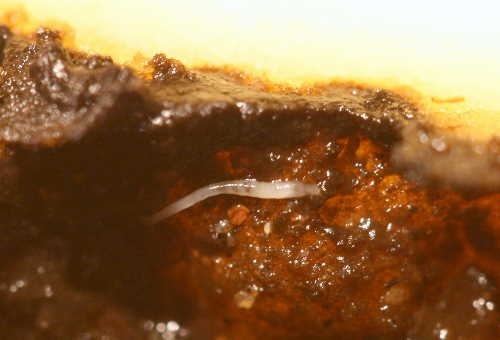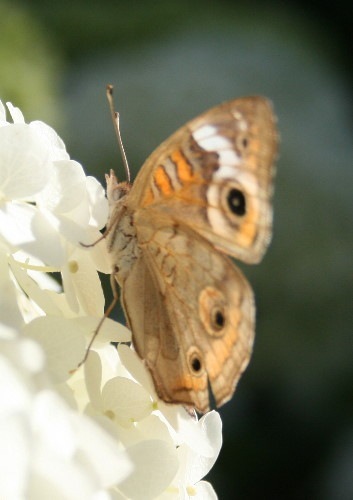
A few weeks ago I was preparing dinner and pulled out and peeled a few potatoes for whatever meal I was making. Three were just fine, but when I cut open the fourth it was dark and decayed all down the centre. I was surprised; there’d been a small blemish at one end, but there are often small blemishes and I just cut them off and use the rest of the potato as normal. But this one was hollowed out.

As I was contemplating whether it was worth cutting out the decayed bits and using whatever was left, or if the smell/taste of the decay might have permeated the whole potato, I saw what I thought was a bit of movement. Tiny, thin slivers of silvery-white, no wider than two or three hairs. I thought they were hairs at first, until they started crawling.
So I did what anyone who found their grocery-store potato infested with tiny silver worms would do: I put the potato slices in a bowl, covered the top with cling wrap, poked a couple of holes in it, and brought it up to my study for observation.
I wasn’t sure what to expect. I was kind of thinking they might be fruit flies, because that seemed the most logical choice for an insect that’s snuck home in fresh produce. But I figured if I just exercised a bit of patience, hopefully I would see. If they were in fact fruit flies, I’d have less than two weeks to wait – which is how long it takes a fruit fly to go from egg to adult stage.
I kept checking on it. After a couple of days I realized the potato was starting to dry out, so I started spritzing it once a day with water to try to keep it moist (not too much; I didn’t want them to drown). It would’ve been better if I hadn’t peeled the potato, but at the time I was peeling it I didn’t realize it held a secret inside.

Five days later, when I peered closely I noticed what seemed like a lot of tiny pearl-white seeds congregated in one spot within the decay. This was exciting! I figured they were nymphs, or the next life stage of whatever it was that the potato was growing. I got my camera and macro lens and got the closest shot I could of them.

This is the image, cropped to 100% – as close as I could get. I’ve been having some trouble with my camera card reader on my computer – it works, but takes some patient fiddling with – so I didn’t check them out closely right away. On the back of the camera, though, they kind of looked like tiny beetles, like maybe a nymph stage. I knew that beetles have a worm-like grub stage, and I’d already observed worm-like grubs, so that’s what I figured they were. Beetles. Just needed to wait till they grew into adults to find out what type.
I waited some more. Another few days went by. Finally, one afternoon I peered in to the bowl and there it was! The adult!
It wasn’t a beetle.
It was, in fact, a gnat of some sort. (Beetles, I learned upon further research, don’t have a nymph stage; their larval instars all look roughly the same. Ditto for gnats. More on this later.) Unfortunately, it accidentally got squished before I could get a photo, and only two adults ever emerged from the potato halves; I wondered if I hadn’t been keeping it damp enough in the decaying sections. So I don’t have a photo and can’t definitively say what it was. But it looked something like this:

This happens to be a fungus gnat that drowned itself in my tea a couple of years ago.
My beloved Kaufman Guide to Insects doesn’t have much on gnats, so I turned to Google, which knows everything. Fungus gnats can be a real nuisance problem with indoor houseplants, and nearly everything Google turned up pertained to using a raw potato slice, placed on the soil surface, to draw the fungus gnats out of hiding so they can be removed. From this I deduced that they must actually use potatoes as hosts, at least occasionally.
I had to dig a little deeper but I did finally find a page in amongst the household remedy hits that confirmed this. This University of Florida information page said:
Most species of darkwinged fungus gnats (Sciaridae) feed on fungi and decaying organic matter and are not considered economic problems. A few species, however, attack healthy tissue of such economic plants as potatoes, wheat, red clover, alfalfa, cultivated mushrooms, pine seedlings, and various ornamentals, including tulip bulbs, ferns, begonias, coleus, geraniums, cacti, young orchids, areca palm, and dracaenas.
That’s quite the list! But heading it up is potatoes, which was the one I was interested in at the moment. Figure 2 on the page is actually of the worm-like larvae in a decaying potato.
Anyway, back to this photo:

I thought it was a larval stage of the beetle-no-actually-gnat. Until I double-checked the life cycles of beetles and gnats, and neither turned up any reference to a tiny, globular larval stage. That’s weird, I thought. But I image-googled “fungus gnat larva” to be sure. It was all photos of adults or the thin, silvery worms… except there were a couple that were round, slightly-haired critters.
Following the first image brought me to this bug-control page, which was a sales page for a live shipment of the invertebrate Hypoaspis miles. They’re predatory mites, and one of their primary prey items is – you guessed it – fungus gnat larvae. It says they are a soil mite, native, and fairly versatile in terms of habitat/substrate. Was that what I had? Predatory mites that ate all my fungus gnat larvae which was why I only got two adult gnats? Unfortunately, I don’t think the photos I took are of good enough quality to know for sure, but that’s the way I’m leaning.
So even though I only got two adults and ended up with more mysteries than answers, I’m considering the potato experiment a success.












 Photo by Bruce Barrett (nordicshutter) on Flickr; CC-licensed (the only such photo I found of a moose jumping, though there are others that are not CC)
Photo by Bruce Barrett (nordicshutter) on Flickr; CC-licensed (the only such photo I found of a moose jumping, though there are others that are not CC)






